2008 MERCEDES-BENZ E-CLASS ESTATE change time
[x] Cancel search: change timePage 4 of 401
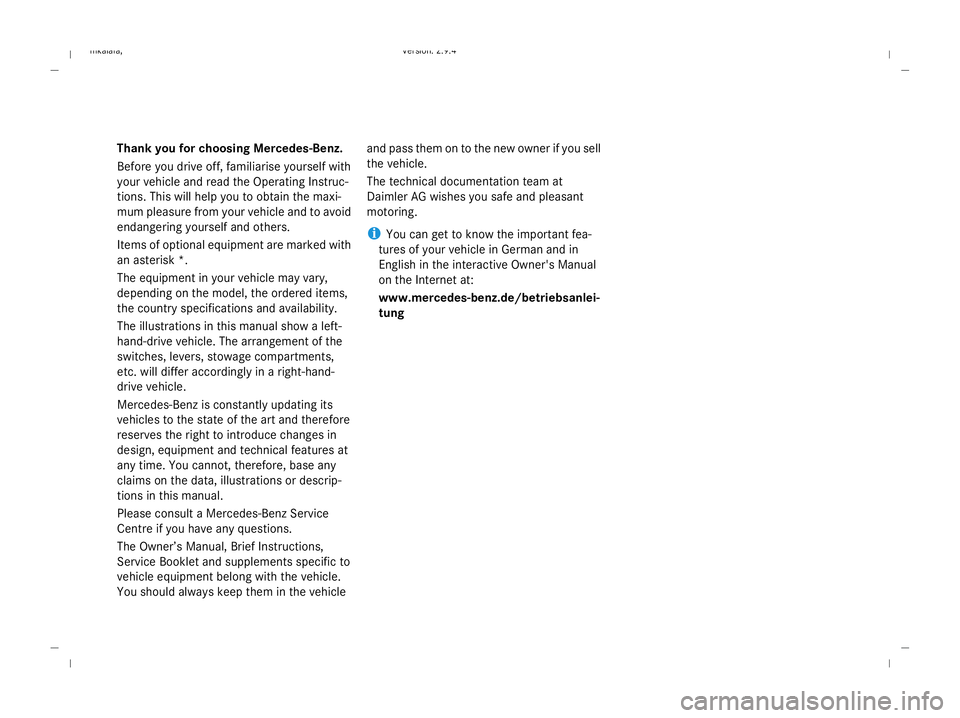
Thank you for choosing Mercedes-Benz.
Before you drive off, familiarise yourself with
your vehicle and read the Operating Instruc-
tions. This will help you to obtain the maxi-
mum pleasure from your vehicle and to avoid
endangering yourself and others.
Items of optional equipment are marked with
an asterisk *.
The equipment in your vehicle may vary,
depending on the model, the ordered items,
the country specifications and availability.
The illustrations in this manual show a left-
hand-drive vehicle. The arrangement of the
switches, levers, stowage compartments,
etc. will differ accordingly in a right-hand-
drive vehicle.
Mercedes-Benz is constantly updating its
vehicles to the state of the art and therefore
reserves the right to introduce changes in
design, equipment and technical features at
any time. You cannot, therefore, base any
claims on the data, illustrations or descrip-
tions in this manual.
Please consult a Mercedes-Benz Service
Centre if you have any questions.
The Owner’s Manual, Brief Instructions,
Service Booklet and supplements specific to
vehicle equipment belong with the vehicle.
You should always keep them in the vehicle and pass them on to the new owner if you sell
the vehicle.
The technical documentation team at
Daimler AG wishes you safe and pleasant
motoring.
i
You can get to know the important fea-
tures of your vehicle in German and in
English in the interactive Owner's Manual
on the Internet at:
www.mercedes-benz.de/betriebsanlei-
tung
211_AKB; 2; 5, en-GB
mkalafa,
Version: 2.9.4 2008-02-29T16:57:07+01:00 - Seite 1Dateiname: 6515_3416_02_buchblock.pdf; preflight
Page 8 of 401
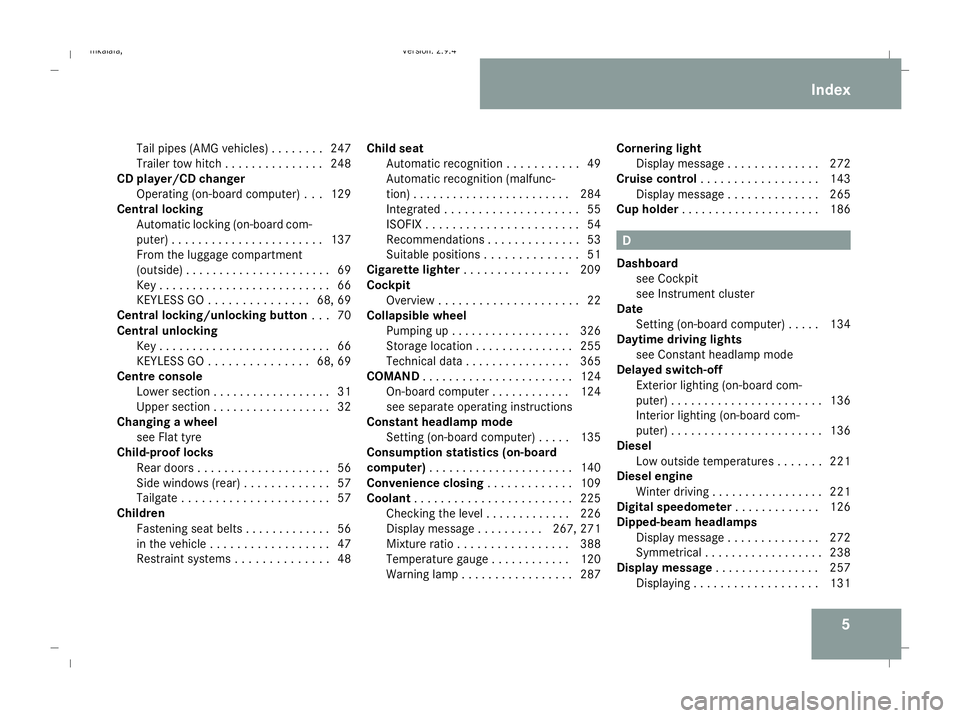
5
Tail pipes (AMG vehicles) . . . . . . .
.247
Trailer tow hitch . . . . . . . . . . . . . . .248
CD player/CD changer
Operating (on-board computer) . . .129
Central locking
Automatic locking (on-board com-
puter) . . . . . . . . . . . . . . . . . . . . . . .137
From the luggage compartment
(outside ).. . . . . . . . . . . . . . . . . . . . .69
Key . . . . . . . . . . . . . . . . . . . . . . . . . .66
KEYLESS GO . . . . . . . . . . . . . . .68, 69
Central locking/unlocking button . ..70
Central unlocking Key . . . . . . . . . . . . . . . . . . . . . . . . . .66
KEYLESS GO . . . . . . . . . . . . . . .68, 69
Centre console
Lower section . . . . . . . . . . . . . . . . . .31
Upper section . . . . . . . . . . . . . . . . . .32
Changing a wheel
see Flat tyre
Child-proof locks
Rear door s.. . . . . . . . . . . . . . . . . . .56
Side windows (rear) . . . . . . . . . . . . .57
Tailgate . . . . . . . . . . . . . . . . . . . . . .57
Children
Fastening seat belt s.. . . . . . . . . . ..56
in the vehicle . . . . . . . . . . . . . . . . . .47
Restraint systems . . . . . . . . . . . . . .48Child seat
Automatic recognition . . . . . . . . . . .49
Automatic recognition (malfunc-
tion) . . . . . . . . . . . . . . . . . . . . . . . .284
Integrated . . . . . . . . . . . . . . . . . . . .55
ISOFIX . . . . . . . . . . . . . . . . . . . . . . .54
Recommendation s.. . . . . . . . . . . . .53
Suitable positions . . . . . . . . . . . . . .51
Cigarette lighter . . . . . . . . . . . . . . . .209
Cockpit Overview . . . . . . . . . . . . . . . . . . . . .22
Collapsible wheel
Pumping up . . . . . . . . . . . . . . . . . .326
Storage location . . . . . . . . . . . . . . .255
Technical data . . . . . . . . . . . . . . . .365
COMAND . . . . . . . . . . . . . . . . . . . . . . .124
On-board computer . . . . . . . . . . . .124
see separate operating instructions
Constant headlamp mode
Setting (on-board computer) . . . . .135
Consumption statistics (on-board
computer) . . . . . . . . . . . . . . . . . . . . . .140
Convenience closing . . . . . . . . . . . ..109
Coolant . . . . . . . . . . . . . . . . . . . . . . . .225
Checking the level . . . . . . . . . . . . .226
Display message . . . . . . . . . .267, 271
Mixture ratio . . . . . . . . . . . . . . . . .388
Temperature gauge . . . . . . . . . . . .120
Warning lamp . . . . . . . . . . . . . . . . .287 Cornering light
Display message . . . . . . . . . . . . . .272
Cruise control . . . . . . . . . . . . . . . . . .143
Display message . . . . . . . . . . . . . .265
Cup holder . . . . . . . . . . . . . . . . . . . . .186 D
Dashboard see Cockpit
see Instrument cluster
Date
Setting (on-board computer) . . . . .134
Daytime driving lights
see Constant headlamp mode
Delayed switch-off
Exterior lighting (on-board com-
puter) . . . . . . . . . . . . . . . . . . . . . . .136
Interior lighting (on-board com-
puter) . . . . . . . . . . . . . . . . . . . . . . .136
Diesel
Low outside temperatures . . . . . . .221
Diesel engine
Winter driving . . . . . . . . . . . . . . . . .221
Digital speedometer . . . . . . . . . . . ..126
Dipped-beam headlamps Display message . . . . . . . . . . . . . .272
Symmetrical . . . . . . . . . . . . . . . . . .238
Display message . . . . . . . . . . . . . . ..257
Displaying . . . . . . . . . . . . . . . . . . .131 Index
211_AKB; 2; 5, en-GB
mkalafa,
Version: 2.9.4
2008-02-29T16:57:07+01:00 - Seite 5 Dateiname: 6515_3416_02_buchblock.pdf; preflight
Page 19 of 401
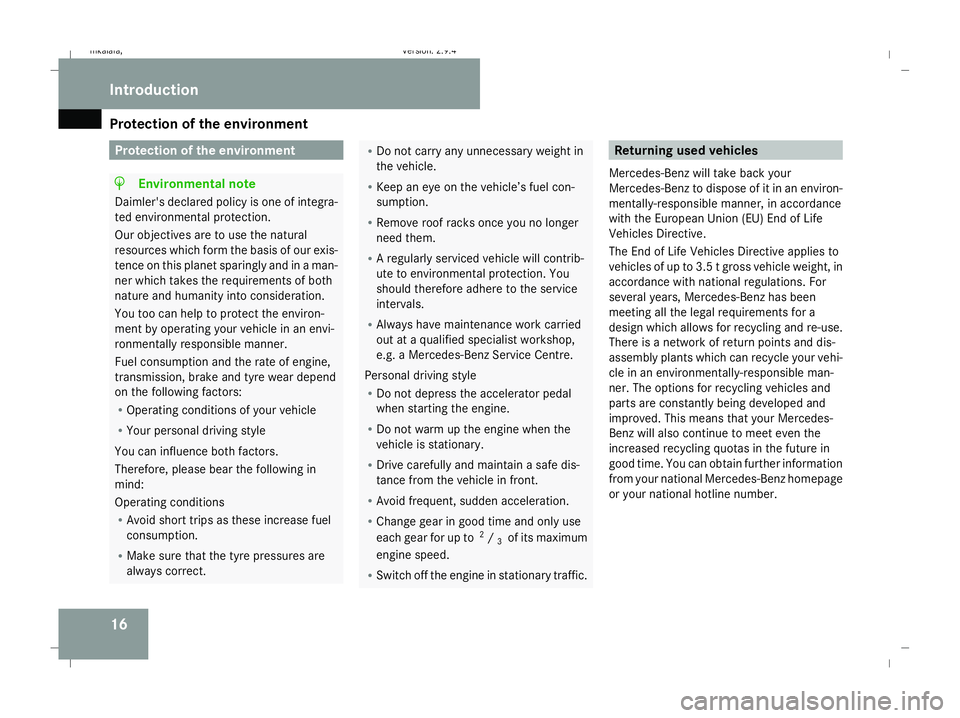
Protection of the environment
16 Protection of the environment
H
Environmental note
Daimler's declared policy is one of integra-
ted environmental protection.
Our objectives are to use the natural
resources which form the basis of our exis-
tence on this planet sparingly and in a man-
ner which takes the requirements of both
nature and humanity into consideration.
You too can help to protect the environ-
ment by operating your vehicle in an envi-
ronmentally responsible manner.
Fuel consumption and the rate of engine,
transmission, brake and tyre wear depend
on the following factors:
R Operating conditions of your vehicle
R Your personal driving style
You can influence both factors.
Therefore, please bear the following in
mind:
Operating conditions
R Avoid short trips as these increase fuel
consumption.
R Make sure that the tyre pressures are
always correct. R
Do not carry any unnecessary weight in
the vehicle.
R Keep an eye on the vehicle’s fuel con-
sumption.
R Remove roof racks once you no longer
need them.
R A regularly serviced vehicle will contrib-
ute to environmental protection. You
should therefore adhere to the service
intervals.
R Always have maintenance work carried
out at a qualified specialist workshop,
e.g. a Mercedes-Benz Service Centre.
Personal driving style
R Do not depress the accelerator pedal
when starting the engine.
R Do not warm up the engine when the
vehicle is stationary.
R Drive carefully and maintain a safe dis-
tance from the vehicle in front.
R Avoid frequent, sudden acceleration.
R Change gear in good time and only use
each gear for up to 2
/ 3 of its maximum
engine speed.
R Switch off the engine in stationary traffic. Returning used vehicles
Mercedes-Benz will take back your
Mercedes-Benz to dispose of it in an environ-
mentally-responsible manner, in accordance
with the European Union (EU) End of Life
Vehicles Directive.
The End of Life Vehicles Directive applies to
vehicles of up to 3.5 t gross vehicle weight, in
accordance with national regulations. For
several years, Mercedes-Benz has been
meeting all the legal requirements for a
design which allows for recycling and re-use.
There is a network of return points and dis-
assembly plants which can recycle your vehi-
cle in an environmentally-responsible man-
ner. The options for recycling vehicles and
parts are constantly being developed and
improved. This means that your Mercedes-
Benz will also continue to meet even the
increased recycling quotas in the future in
good time. You can obtain further information
from your national Mercedes-Benz homepage
or your national hotline number. Introduction
211_AKB; 2; 5, en-GB
mkalafa,
Version: 2.9.4 2008-02-29T16:57:07+01:00 - Seite 16Dateiname: 6515_3416_02_buchblock.pdf; preflight
Page 59 of 401
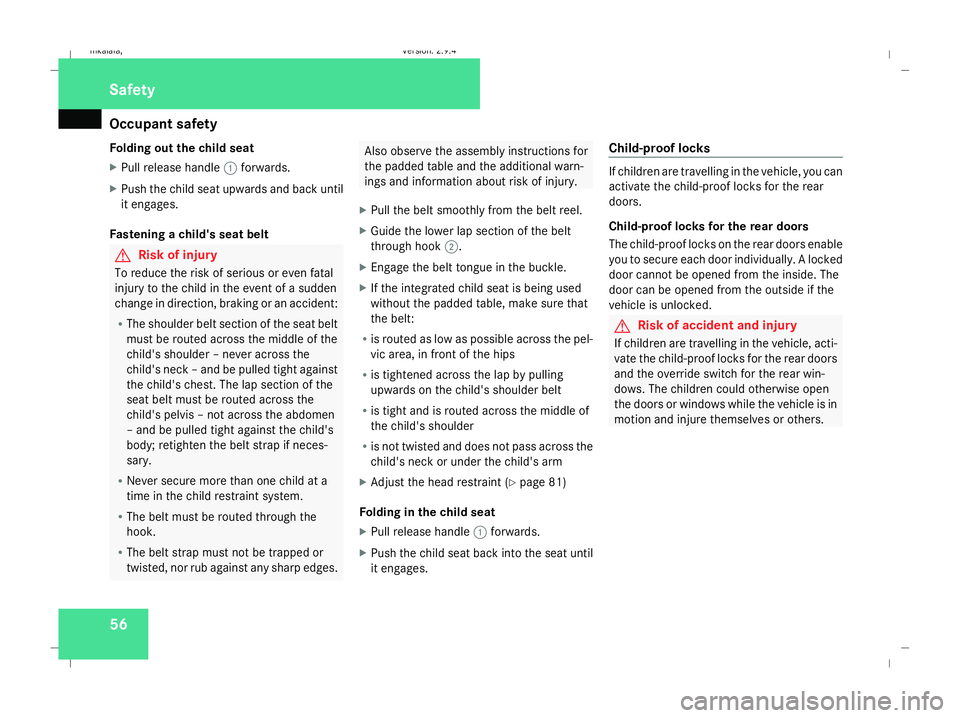
Occupant safety
56
Folding out the child seat
X
Pull release handle 1forwards.
X Push the child seat upwards and back until
it engages.
Fastening a child's seat belt G
Risk of injury
To reduce the risk of serious or even fatal
injury to the child in the event of a sudden
change in direction, braking or an accident:
R The shoulder belt section of the seat belt
must be routed across the middle of the
child's shoulder – never across the
child's neck – and be pulled tight against
the child's chest. The lap section of the
seat belt must be routed across the
child's pelvis – not across the abdomen
– and be pulled tight against the child's
body; retighten the belt strap if neces-
sary.
R Never secure more than one child at a
time in the child restraint system.
R The belt must be routed through the
hook.
R The belt strap must not be trapped or
twisted, nor rub against any sharp edges. Also observe the assembly instructions for
the padded table and the additional warn-
ings and information about risk of injury.
X Pull the belt smoothly from the belt reel.
X Guide the lower lap section of the belt
through hook 2.
X Engage the belt tongue in the buckle.
X If the integrated child seat is being used
without the padded table, make sure that
the belt:
R is routed as low as possible across the pel-
vic area, in front of the hips
R is tightened across the lap by pulling
upwards on the child's shoulder belt
R is tight and is routed across the middle of
the child's shoulder
R is not twisted and does not pass across the
child's neck or under the child's arm
X Adjust the head restraint (Y page 81)
Folding in the child seat
X Pull release handle 1forwards.
X Push the child seat back into the seat until
it engages. Child-proof locks If children are travelling in the vehicle, you can
activate the child-proof locks for the rear
doors.
Child-proof locks for the rear doors
The child-proof locks on the rear doors enable
you to secure each door individually. A locked
door cannot be opened from the inside. The
door can be opened from the outside if the
vehicle is unlocked.
G
Risk of accident and injury
If children are travelling in the vehicle, acti-
vate the child-proof locks for the rear doors
and the override switch for the rear win-
dows. The children could otherwise open
the doors or windows while the vehicle is in
motion and injure themselves or others. Safety
211_AKB; 2; 5, en-GB
mkalafa,
Version: 2.9.4 2008-02-29T16:57:07+01:00 - Seite 56Dateiname: 6515_3416_02_buchblock.pdf; preflight
Page 69 of 401
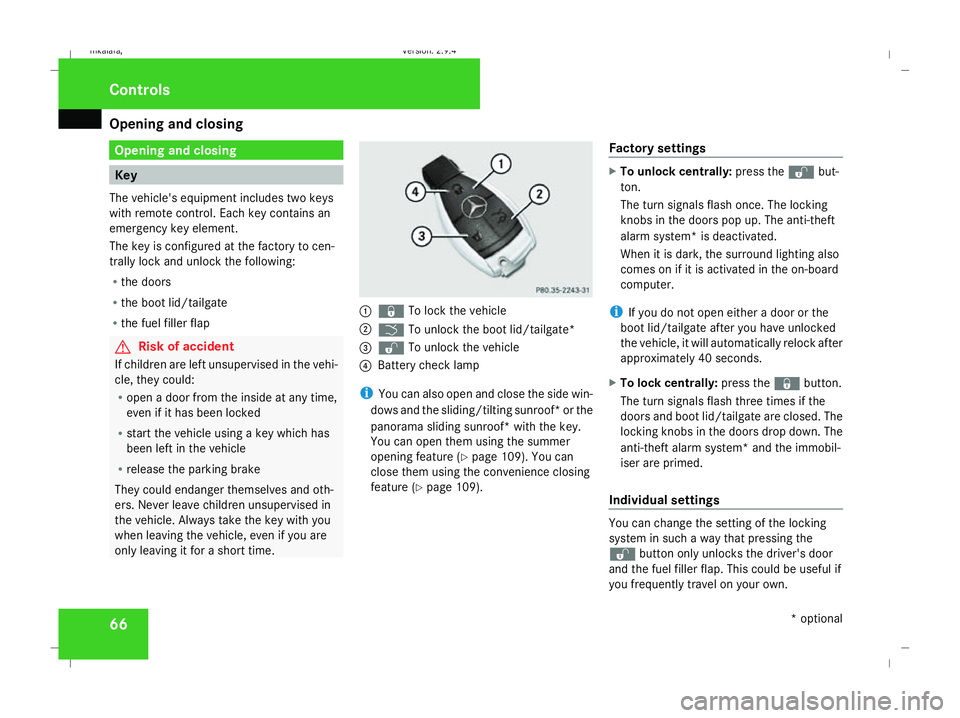
Opening and closing
66 Opening and closing
Key
The vehicle's equipment includes two keys
with remote control. Each key contains an
emergency key element.
The key is configured at the factory to cen-
trally lock and unlock the following:
R the doors
R the boot lid/tailgate
R the fuel filler flap G
Risk of accident
If children are left unsupervised in the vehi-
cle, they could:
R open a door from the inside at any time,
even if it has been locked
R start the vehicle using a key which has
been left in the vehicle
R release the parking brake
They could endanger themselves and oth-
ers. Never leave children unsupervised in
the vehicle. Always take the key with you
when leaving the vehicle, even if you are
only leaving it for a short time. 1
j To lock the vehicle
2 i To unlock the boot lid/tailgate*
3 k To unlock the vehicle
4 Battery check lamp
i You can also open and close the side win-
dows and the sliding/tilting sunroof* or the
panorama sliding sunroof *with the key.
You can open them using the summer
opening feature (Y page 109). You can
close them using the convenience closing
feature (Y page 109). Factory settings X
To unlock centrally: press thekbut-
ton.
The turn signals flash once. The locking
knobs in the doors pop up. The anti-theft
alarm system* is deactivated.
When it is dark, the surround lighting also
comes on if it is activated in the on-board
computer.
i If you do not open either a door or the
boot lid/tailgate after you have unlocked
the vehicle, it will automatically relock after
approximately 40 seconds.
X To lock centrally: press thejbutton.
The turn signals flash three times if the
doors and boot lid/tailgate are closed. The
locking knobs in the doors drop down. The
anti-theft alarm system* and the immobil-
iser are primed.
Individual settings You can change the setting of the locking
system in such a way that pressing the
k
button only unlocks the driver's door
and the fuel filler flap. This could be useful if
you frequently travel on your own. Controls
* optional
211_AKB; 2; 5, en-GB
mkalafa, Version: 2.9.4 2008-02-29T16:57:07+01:00 - Seite 66Dateiname: 6515_3416_02_buchblock.pdf; preflight
Page 70 of 401
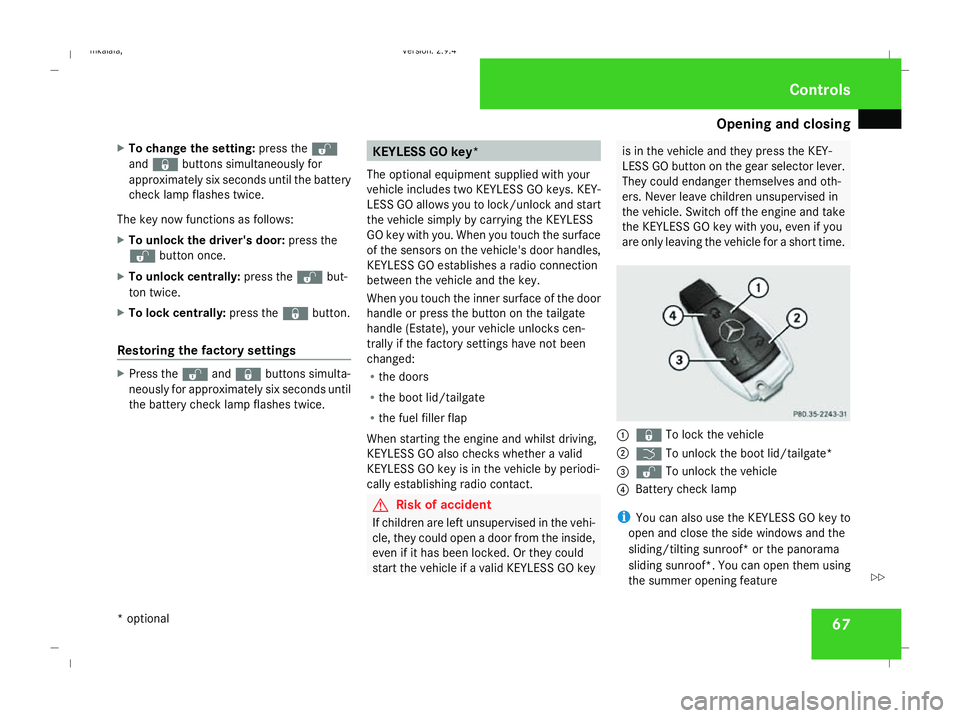
Opening and closing
67
X
To change the setting: press thek
and j buttons simultaneously for
approximately six seconds until the battery
check lamp flashes twice.
The key now functions as follows:
X To unlock the driver's door: press the
k button once.
X To unlock centrally: press thekbut-
ton twice.
X To lock centrally: press thejbutton.
Restoring the factory settings X
Press the kandj buttons simulta-
neously for approximately six seconds until
the battery check lamp flashes twice. KEYLESS GO key*
The optional equipment supplied with your
vehicle includes two KEYLESS GO keys. KEY-
LESS GO allows you to lock/unlock and start
the vehicle simply by carrying the KEYLESS
GO key with you. When you touch the surface
of the sensors on the vehicle's door handles,
KEYLESS GO establishes a radio connection
between the vehicle and the key.
When you touch the inner surface of the door
handle or press the button on the tailgate
handle (Estate), your vehicle unlocks cen-
trally if the factory settings have not been
changed:
R the doors
R the boot lid/tailgate
R the fuel filler flap
When starting the engine and whilst driving,
KEYLESS GO also checks whether a valid
KEYLESS GO key is in the vehicle by periodi-
cally establishing radio contact. G
Risk of accident
If children are left unsupervised in the vehi-
cle, they could open a door from the inside,
even if it has been locked. Or they could
start the vehicle if a valid KEYLESS GO key is in the vehicle and they press the KEY-
LESS GO button on the gear selector lever.
They could endanger themselves and oth-
ers. Never leave children unsupervised in
the vehicle. Switch off the engine and take
the KEYLESS GO key with you, even if you
are only leaving the vehicle for a short time. 1
j To lock the vehicle
2 i To unlock the boot lid/tailgate*
3 k To unlock the vehicle
4 Battery check lamp
i You can also use the KEYLESS GO key to
open and close the side windows and the
sliding/tilting sunroof* or the panorama
sliding sunroof *.You can open them using
the summer opening feature Controls
* optional
211_AKB; 2; 5, en-GB
mkalafa,
Version: 2.9.4
2008-02-29T16:57:07+01:00 - Seite 67 ZDateiname: 6515_3416_02_buchblock.pdf; preflight
Page 71 of 401
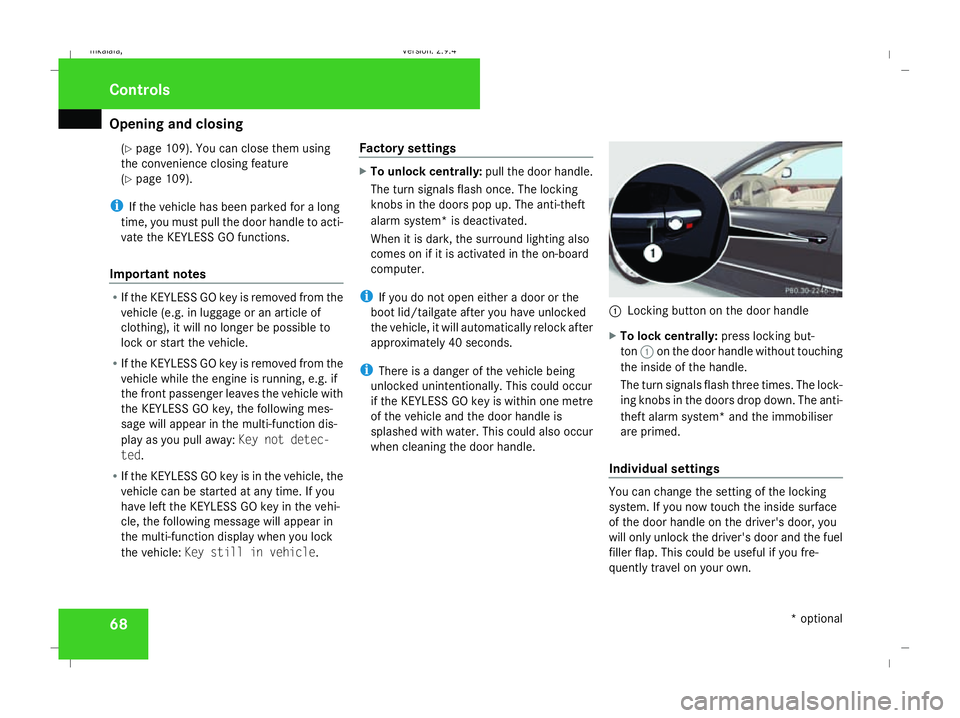
Opening and closing
68(Y
page 109). You can close them using
the convenience closing feature
(Y page 109).
i If the vehicle has been parked for a long
time, you must pull the door handle to acti-
vate the KEYLESS GO functions.
Important notes R
If the KEYLESS GO key is removed from the
vehicle (e.g. in luggage or an article of
clothing), it will no longer be possible to
lock or start the vehicle.
R If the KEYLESS GO key is removed from the
vehicle while the engine is running, e.g. if
the front passenger leaves the vehicle with
the KEYLESS GO key, the following mes-
sage will appear in the multi-function dis-
play as you pull away: Key not detec-
ted.
R If the KEYLESS GO key is in the vehicle, the
vehicle can be started at any time. If you
have left the KEYLESS GO key in the vehi-
cle, the following message will appear in
the multi-function display when you lock
the vehicle: Key still in vehicle .Factory settings X
To unlock centrally: pull the door handle.
The turn signals flash once. The locking
knobs in the doors pop up. The anti-theft
alarm system* is deactivated.
When it is dark, the surround lighting also
comes on if it is activated in the on-board
computer.
i If you do not open either a door or the
boot lid/tailgate after you have unlocked
the vehicle, it will automatically relock after
approximately 40 seconds.
i There is a danger of the vehicle being
unlocked unintentionally. This could occur
if the KEYLESS GO key is within one metre
of the vehicle and the door handle is
splashed with water. This could also occur
when cleaning the door handle. 1
Locking button on the door handle
X To lock centrally: press locking but-
ton 1on the door handle without touching
the inside of the handle.
The turn signals flash three times. The lock-
ing knobs in the doors drop down. The anti-
theft alarm system* and the immobiliser
are primed.
Individual settings You can change the setting of the locking
system. If you now touch the inside surface
of the door handle on the driver's door, you
will only unlock the driver's door and the fuel
filler flap. This could be useful if you fre-
quently travel on your own. Controls
* optional
211_AKB; 2; 5, en-GB
mkalafa,
Version: 2.9.4 2008-02-29T16:57:07+01:00 - Seite 68Dateiname: 6515_3416_02_buchblock.pdf; preflight
Page 72 of 401
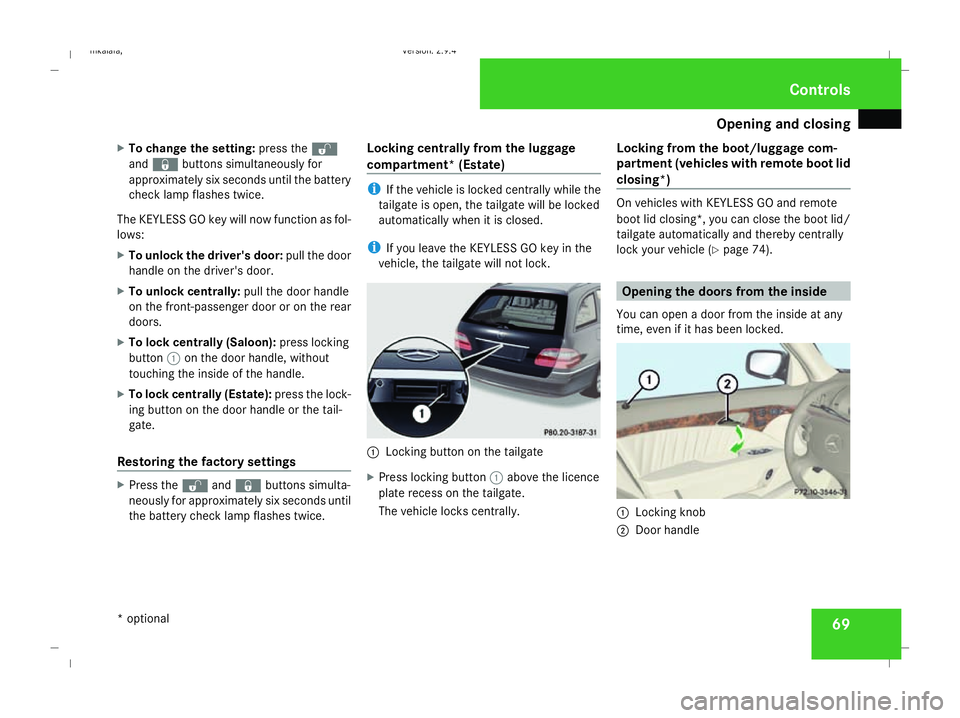
Opening and closing
69
X
To change the setting: press thek
and j buttons simultaneously for
approximately six seconds until the battery
check lamp flashes twice.
The KEYLESS GO key will now function as fol-
lows:
X To unlock the driver's door: pull the door
handle on the driver's door.
X To unlock centrally: pull the door handle
on the front-passenger door or on the rear
doors.
X To lock centrally (Saloon): press locking
button 1on the door handle, without
touching the inside of the handle.
X To lock centrally (Estate): press the lock-
ing button on the door handle or the tail-
gate.
Restoring the factory settings X
Press the kandj buttons simulta-
neously for approximately six seconds until
the battery check lamp flashes twice. Locking centrally from the luggage
compartment* (Estate) i
If the vehicle is locked centrally while the
tailgate is open, the tailgate will be locked
automatically when it is closed.
i If you leave the KEYLESS GO key in the
vehicle, the tailgate will not lock. 1
Locking button on the tailgate
X Press locking button 1above the licence
plate recess on the tailgate.
The vehicle locks centrally. Locking from the boot/luggage com-
partment (vehicles with remote boot lid
closing*) On vehicles with KEYLESS GO and remote
boot lid closing*, you can close the boot lid/
tailgate automatically and thereby centrally
lock your vehicle (
Ypage 74). Opening the doors from the inside
You can open a door from the inside at any
time, even if it has been locked. 1
Locking knob
2 Door handle Controls
* optional
211_AKB; 2; 5, en-GB
mkalafa,
Version: 2.9.4 2008-02-29T16:57:07+01:00 - Seite 69 ZDateiname: 6515_3416_02_buchblock.pdf; preflight